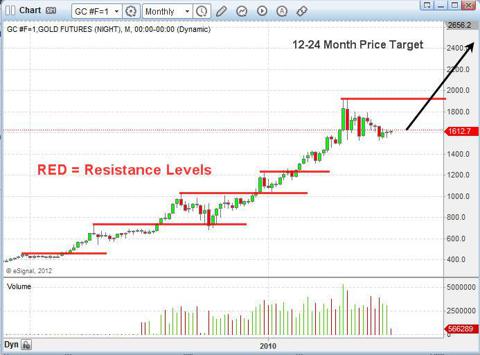Gold Outlook Still Bullish And Ripening For Melt Up
August 8, 2012
by: Chris Vermeulen
Gold has enjoyed a 12-year run of higher prices. Gold bears and the lovers of paper money are asking whether this is the year when gold finally ends its run and finishes the year lower than last year's close of $1,566.80 an ounce. This question is of utmost interest to holders of any of the gold ETFs including the SPDR Gold Trust GLD), the iShares COMEX Gold Trust IAU) and the ETF Securities Swiss Gold Shares SGOL).
Obviously, the more than decade-long rally must end sooner or later, as nothing goes up in price forever or as the old adage says, "Trees don't grow to the sky." Gold has been consolidating now, since its peak last September at $1920 an ounce, for longer than any other time since the bull market began. It is down about 17% from the peak, which is not a good feeling for those who bought at the peak. But bear in mind that during gold's run in the 1970s-80s, it went down by around 50% before eventually gaining eightfold in value.
A few recent research reports also suggest that the yellow metal is not dead yet, and that conditions are still ripe for higher prices for gold. Bullion Vault recently pointed out the fact that in the last ten years, every time the gold price has sat around doing nothing for about a year, it has subsequently gained on average 33% the following year.
(click to enlarge)

In his annual In Gold We Trust report, Ronald Stoeferle of Austria's Erste Bank states that the basis for new all-time highs is firmly in place. His main thesis is that interest rates in the developed economies will continue to be kept near zero so that the governments can continue their huge and rapidly growing debts.
Basically, Mr. Stoeferle is saying what most gold bulls already know. Governments and central banks in the developed world will continue to act together to hold borrowing costs down by printing as much paper currency as needed to purchase government bonds. That translates to debasement of their currencies versus the only currency that is not solely backed by 'the full faith and credit' of any nation, namely gold.
Mr. Stoeferle pointed to another factor supporting gold: negative interest rates. When interest rates are below the rate of inflation, that obviously is bad for savers, forcing some at least to think about gold (and silver) as a means to preserve their wealth. During the inflationary 1970s, real interest rates were negative in 54% of the months. Since 2000, real interest rates have been negative 51% of the time, which in the words of Mr. Stoeferle, "constitutes an optimal environment for gold".
This is especially true in emerging markets, such as China. The emerging markets, in the last five years, drove 70% of the demand for gold. A quote from the In Gold We Trust report states:
The gold price in terms of purchasing power in China and India is currently about 80% lower than in 1980. This means that, to Asian investors, gold is still amazingly cheap.
Although governments can interfere with that price signal. Just look at India, where its central bank is waging war on gold.
The message from this research for gold investors? No one knows for certain how long this consolidation period in gold will continue, but the environment seems ripe for higher gold prices in the months and years ahead.

0 comments:
Publicar un comentario